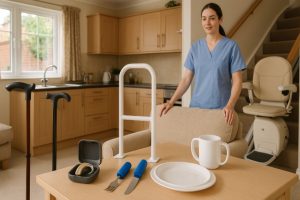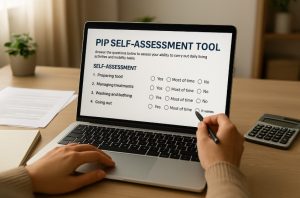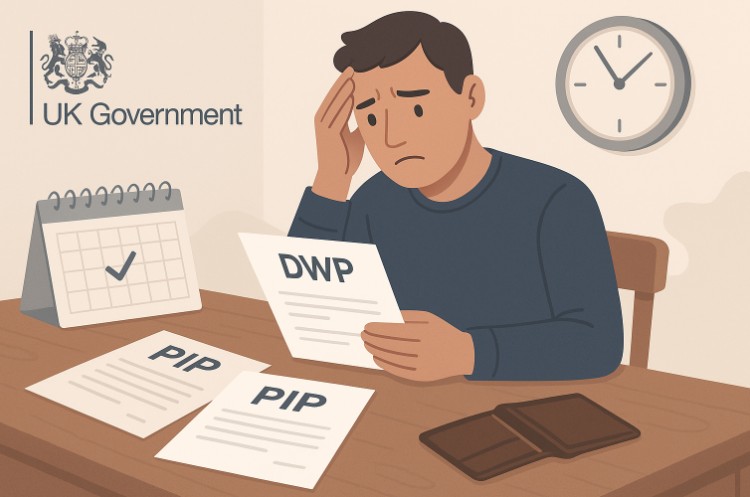Understanding how Personal Independence Payment (PIP) works and how to approach the assessment interview can make a crucial difference in the outcome of your claim.
This guide covers the types of questions asked, how the points system operates, and what you can do to prepare effectively for your PIP interview.
What Is the Personal Independence Payment (PIP) and How Does It Work?

Personal Independence Payment (PIP) is a UK government benefit offered to individuals who have long-term physical or mental health conditions or disabilities.
It is designed to help cover the extra costs associated with living with these conditions. PIP is not means-tested or based on national insurance contributions and is available to people whether they are in work or not.
The benefit is divided into two parts:
- Daily Living Component
- Mobility Component
Each component is paid at either a standard or enhanced rate. The amount awarded depends on how a person’s condition affects them in carrying out specific everyday tasks rather than on the condition itself.
To determine eligibility, claimants must complete an initial form followed by an assessment interview where they are asked questions based on defined criteria.
What Are the Key Daily Living Questions Asked During a PIP Assessment?
The daily living component of the PIP assessment evaluates how a person’s disability or health condition affects their ability to carry out essential day-to-day activities.
This part of the assessment focuses on functional ability, not just diagnosis or treatment. The questions are structured to explore how the condition impacts the claimant’s independence, safety, and ability to perform each task consistently and reliably.
There are 10 daily living activities, each with its own set of descriptors. During the interview, the health professional will ask questions aimed at understanding the frequency, difficulty, need for help, or use of aids required for each activity.
The assessment is holistic, so the questions aren’t just a checklist—they’re designed to build a full picture of how the claimant copes in real life.
1. Preparing Food
Questions in this section assess whether the person can prepare and cook a simple meal using fresh ingredients. The assessor may ask:
- Can you peel and chop vegetables safely?
- Do you use a microwave instead of a conventional oven?
- Do you need help to lift pans or use kitchen tools?
This activity includes not only cooking but also planning, sequencing steps, and safety awareness. Even if someone can technically cook, they may struggle due to fatigue, confusion, pain, or risk of accidents.
Points range from 0 to 8, depending on the level of aid, prompting, or supervision required.
2. Taking Nutrition
This area explores a person’s ability to eat and drink independently. It includes:
- Cutting up food
- Using cutlery
- Bringing food to the mouth
- Managing feeding tubes or therapeutic nutrition
Typical questions may include:
- Do you need someone to remind or encourage you to eat?
- Do you use any special equipment like adapted cutlery?
- Can you chew and swallow food without difficulty?
Points are awarded based on the type of support needed, with more points given for more intensive help.
3. Managing Therapy or Monitoring a Health Condition
This section looks at how well the person manages their treatment regimen. It includes taking medication, monitoring symptoms, and performing therapeutic activities such as physiotherapy or wound care.
The assessor may ask:
- Do you take any regular medication? If so, how do you remember to take it?
- Do you require help from another person to administer injections or manage treatment?
- Do you need prompting or supervision when monitoring symptoms like blood sugar or breathing?
Points depend on the time and complexity of the therapy and the level of support required.
4. Washing and Bathing
This activity assesses the ability to maintain personal hygiene. It involves tasks such as:
- Getting into and out of the bath or shower
- Washing hair and body
- Using taps and washing aids
Questions might include:
- Do you bathe without help?
- Do you use any aids like grab rails, shower seats, or long-handled sponges?
- Is help required for some body parts only (e.g., back, lower body)?
Even if a person is able to wash some parts, needing assistance with other areas can still result in points being awarded.
5. Managing Toilet Needs or Incontinence
This category evaluates the person’s ability to use the toilet, manage clothing, and deal with continence issues.
The assessor might ask:
- Can you get to the toilet in time?
- Do you need help cleaning yourself afterward?
- Do you use pads, catheters, or a commode?
Scoring considers not only physical assistance but also aids, prompting, and supervision.
6. Dressing and Undressing
This section focuses on the ability to choose appropriate clothing and dress independently. It assesses:
- Physical dexterity (e.g., zips, buttons)
- Decision-making ability (e.g., selecting weather-appropriate clothing)
Questions may include:
- Do you need help dressing your upper or lower body?
- Do you struggle with fasteners or tight clothing?
- Does anyone help you select what to wear?
Points range from 0 for full independence to 8 for being completely unable to dress without assistance.
7. Communicating Verbally
This activity looks at a person’s ability to communicate verbally in a way others can understand and to understand spoken language. It’s not limited to speech but includes:
- Hearing impairments
- Speech difficulties
- Cognitive or psychological issues affecting communication
The assessor may ask:
- Do you use any communication aids?
- Do you need someone to explain things more than once?
- Are there situations where you cannot express yourself clearly?
Support could be in the form of lip-reading, sign language, or assistance from another person.
8. Reading and Understanding Signs, Symbols and Words
This measures the ability to read and understand written information like letters, bills, or signs. It also includes cognitive ability to interpret written material.
Questions might include:
- Can you read prescription labels or appointment letters?
- Do you rely on someone to read things to you?
- Do you use magnifiers or other visual aids?
Points are awarded based on the use of aids, prompting, or complete inability to understand written information.
9. Engaging with Other People Face to Face
This assesses whether someone can socially engage with others, including:
- Family
- Friends
- Medical professionals or strangers
Relevant conditions may include anxiety, PTSD, depression, autism, or cognitive impairments.
The assessor may ask:
- Do you avoid social situations?
- Do you need someone to be with you to feel safe in public?
- Does interacting with others cause overwhelming distress?
Scoring ranges from no issues (0 points) to being unable to engage at all (8 points).
10. Making Budgeting Decisions
This final daily living activity focuses on financial decision-making. It assesses cognitive and emotional ability to:
- Understand bills and banking
- Handle money responsibly
- Make everyday purchases
Questions could include:
- Can you manage your own finances?
- Do you need someone to explain costs or value?
- Have you made financial mistakes because of your condition?
People requiring assistance for complex or even simple budgeting tasks can score between 2 and 6 points.
Overview of Daily Living Activities and PIP Points
| Daily Living Activity | What It Assesses | Maximum Points |
| Preparing Food | Ability to prepare and cook a simple meal safely and unaided | 8 points |
| Taking Nutrition | Eating, drinking, using cutlery, managing feeding aids | 10 points |
| Managing Therapy or Monitoring a Condition | Managing medication, therapy, and monitoring health independently | 8 points |
| Washing and Bathing | Maintaining personal hygiene, using aids or assistance to wash or bathe | 8 points |
| Managing Toilet Needs or Incontinence | Using the toilet, managing clothing, and dealing with continence issues | 8 points |
| Dressing and Undressing | Physically dressing, selecting appropriate clothing, using aids | 8 points |
| Communicating Verbally | Understanding and expressing verbal information, using aids or communication support | 12 points |
| Reading and Understanding Information | Reading and comprehending signs, symbols, and written communication | 8 points |
| Engaging with Other People Face to Face | Social interaction, psychological impact, and need for support | 8 points |
| Making Budgeting Decisions | Understanding and managing financial tasks and decision-making | 6 points |
How Are PIP Daily Living Points Calculated?

Each activity described in the assessment has a list of descriptors. The assessor determines which descriptor best reflects the claimant’s ability and awards the corresponding points. Only one descriptor from each activity is counted — the one with the highest score that applies.
The table below outlines how points translate into award levels:
| Component | Points Range | Award Rate |
| Daily Living | 8 – 11 | Standard Rate |
| Daily Living | 12 or more | Enhanced Rate |
Claimants must meet the minimum score thresholds based on how their impairments impact them over at least 50% of days in a 12-month period. The assessment considers fluctuating conditions and determines the most accurate descriptor across time.
What Are the Questions Asked in the Mobility Component of the PIP Interview?
Mobility-related questions are structured to evaluate a person’s capacity to travel independently and their physical ability to move around.
Planning and Following Journeys
This evaluates mental and cognitive ability to navigate from one place to another.
- Questions may include whether the person can follow unfamiliar routes or if psychological distress prevents travel
- A person who cannot follow familiar journeys unaided may score 12 points
Moving Around
This section reviews physical ability to walk and includes the use of aids such as sticks or wheelchairs.
- An inability to move more than one metre may result in a maximum score of 12 points
How Are PIP Mobility Points Scored?

As with daily living, each mobility activity has specific descriptors. The scores from both mobility activities are combined to determine the award level.
| Component | Points Range | Award Rate |
| Mobility | 8 – 11 | Standard Rate |
| Mobility | 12 or more | Enhanced Rate |
Only the descriptor with the highest point score from each activity is considered. A total of 8 points or more across the two activities is needed to receive an award.
How Can You Prepare for a PIP Interview Effectively?
Preparing for the PIP assessment involves a combination of reviewing your application, collecting supporting evidence, and practising how to express how your condition affects you. Here are some practical preparation tips:
- Re-read your submitted PIP claim form before the interview
- Have a clear idea of what your worst days look like
- Prepare examples for each activity listed in the assessment
- Collect supporting documents such as letters from doctors, therapists, or support workers
- Consider attending with a carer or family member who can help describe your condition
This preparation not only helps clarify your case but can also reduce anxiety during the actual interview.
What Does “Reliably, Repeatedly, Safely and in a Timely Manner” Mean in a PIP Assessment?
The ability to complete an activity must be considered against four important criteria:
- Reliably: To a reasonable standard
- Repeatedly: As often as required
- Safely: Without causing harm to oneself or others
- In a Timely Manner: Not taking significantly longer than someone without a disability
For example, if a person can physically walk 50 metres but experiences extreme fatigue afterwards that prevents them from walking again that day, they may not be considered able to move around “repeatedly” and therefore could qualify for a higher score.
What Should You Know About Aids, Appliances and Support from Others?

The use of aids, appliances, or human support significantly influences scoring. The following are typically taken into account:
- Aids: Items that help a person perform an activity such as hearing aids, grab rails, or walking sticks
- Appliances: Devices that perform a function such as a wheelchair or a stoma bag
- Support from Others: May involve physical assistance, prompting, or supervision
A claimant does not need to already own or use an aid for it to be considered. If it is reasonable for someone with their condition to use an aid, it will still be factored into the decision.
What Are Common Mistakes to Avoid in a PIP Interview?
Even well-prepared claimants can face difficulties during their assessment if common mistakes are made. These include:
- Understating difficulties to appear more capable
- Failing to provide specific examples
- Not explaining the frequency or impact of symptoms
- Forgetting to mention side effects from medications
- Allowing pride or discomfort to stop honest disclosure
Claimants should focus on how their condition affects them day-to-day and not just describe their good days.
How Do You Appeal If Your PIP Application Is Rejected?
In the event of a denial or unsatisfactory award level, a multi-step appeal process is available. This involves:
- Requesting a Mandatory Reconsideration within one month of the decision
- Providing additional evidence if possible
- Taking the case to a tribunal if the reconsideration is unsuccessful
Claimants are encouraged to use official guidance or consult disability support organisations during the appeals process.
How Does the Transition from DLA to PIP Affect Points and Eligibility?
When claimants are moved from Disability Living Allowance (DLA) to PIP, they undergo a fresh assessment. Key differences between the two systems include:
- PIP uses a structured points system rather than focusing only on medical conditions
- Assessments are conducted by external assessors, not based solely on previous documentation
- Higher thresholds and more detailed functional evidence are required for the enhanced rates
People who qualified for the highest rates under DLA might not automatically receive the same under PIP unless their assessment clearly demonstrates the required level of difficulty.
How Can You Track or Estimate Your PIP Score Before the Interview?

Several organisations and government-backed platforms offer self-assessment tools to help claimants understand where they may fall within the PIP scoring system. These tools allow users to:
- Select descriptors that apply to them
- Receive an estimate of their total score
- Identify where more supporting evidence is required
While not a substitute for the real assessment, these tools are helpful for planning and for clarifying what to expect.
Conclusion
Preparing for a PIP interview involves more than just answering questions; it requires a clear understanding of how the points system works and how your condition impacts your daily life.
By reviewing the assessment criteria, gathering evidence, and practising responses, claimants can present a more accurate picture of their needs.
Understanding what the assessors look for ensures a fairer outcome and improves the chance of receiving the right support through the Personal Independence Payment system.
FAQs
What should you wear to a PIP interview?
There is no dress code, but it’s advisable to dress as you normally would. Avoid overcompensating or trying to appear “better” than your condition allows, as this could mislead assessors.
How long does a PIP interview usually take?
Most interviews last 60 to 90 minutes, depending on the complexity of your case and how much evidence you need to explain.
Do PIP assessors contact your doctor?
They may contact your GP or other healthcare professionals if more medical information is needed, but this is not guaranteed.
Is it better to attend a face-to-face or video PIP assessment?
Both are equally valid. However, face-to-face assessments may give the assessor more context through body language and mobility.
Can someone attend the PIP interview with you?
Yes. You can bring a friend, family member or support worker to the interview. They can help you stay focused and provide extra context.
How long does it take to get a decision after a PIP interview?
It typically takes 4 to 6 weeks, but delays can occur. You’ll receive a decision letter outlining your scores and entitlement.
What happens if you miss your PIP interview?
If you miss it without a valid reason, your claim may be disallowed. Always call ahead to reschedule if you’re unable to attend.






